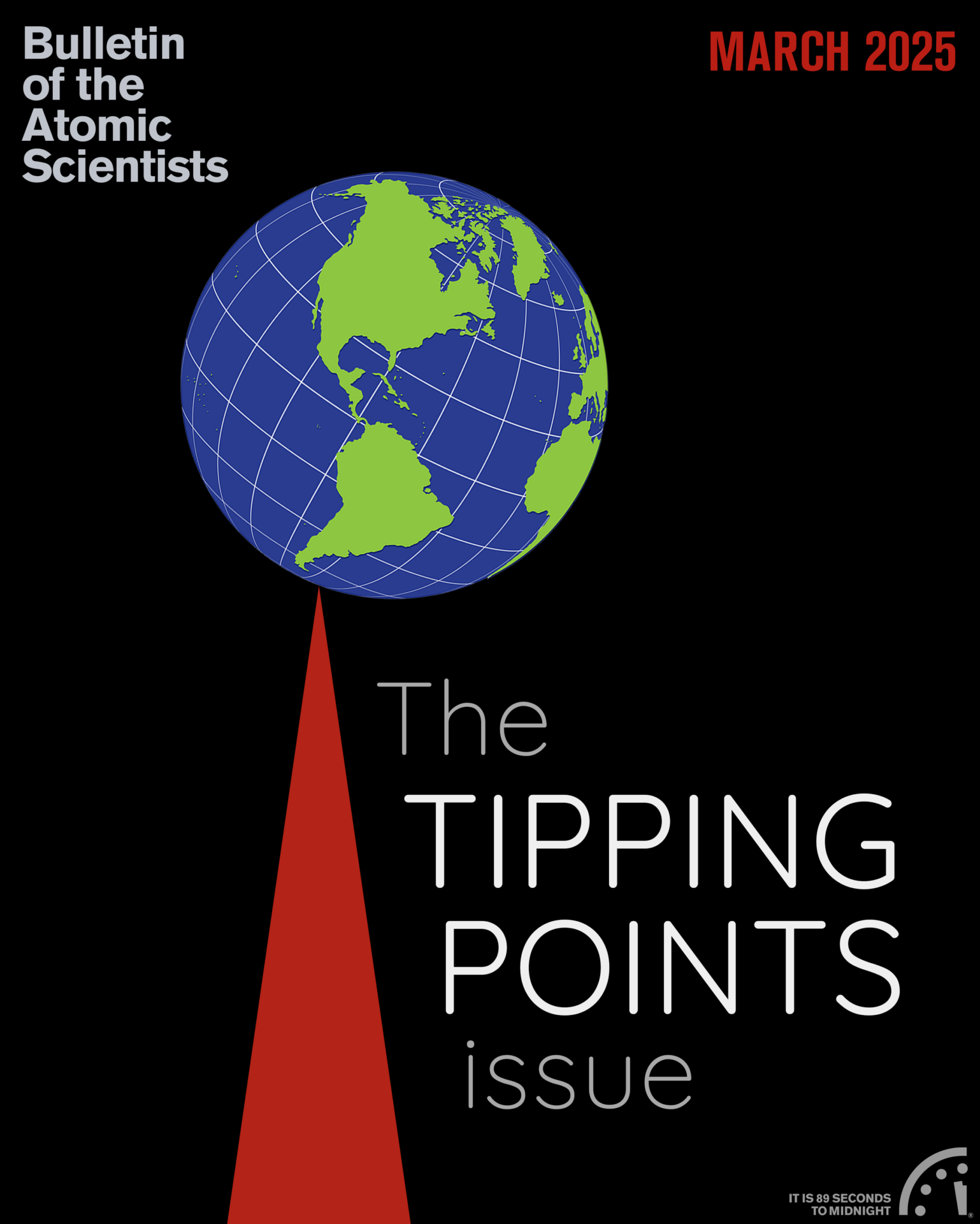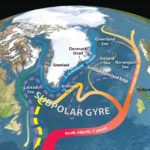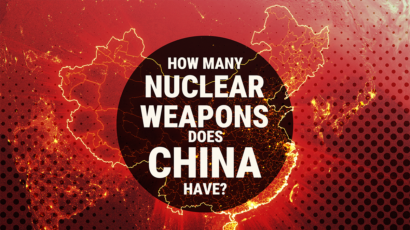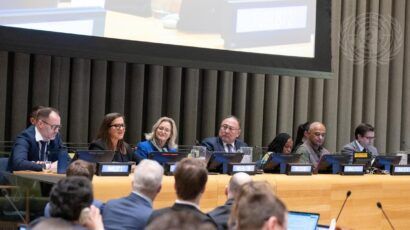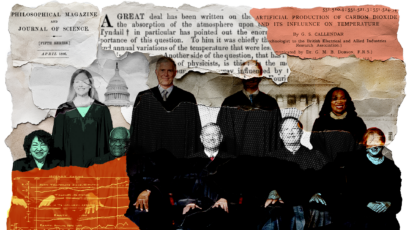Climate change will surprise us, but so-called ‘tipping points’ may lead us astray
By Robert Kopp, Elisabeth Gilmore, Rachael Shwom | March 12, 2025
Climate change will surprise us, but so-called ‘tipping points’ may lead us astray
By Robert Kopp, Elisabeth Gilmore, Rachael Shwom | March 12, 2025
Over the last 20 years, it has become increasingly common to describe a range of phenomena—both in the climate system and in human affairs related to climate change—as “tipping points” (Lenton et al., 2023). This issue of The Bulletin of Atomic Scientists discusses examples that range from changes in the ocean circulation and ice sheets, to changes in the carbon cycle and ecosystems, to decarbonization.
The climate scientists who first adopted and promoted the tipping points terminology sought to emphasize the urgency of climate action and encourage optimism about its feasibility and pace. These goals were explicit in the earliest work on the topic, and they are goals with which we agree. But we disagree that the tipping points framing is effective at either promoting a clear understanding of how the climate works or at achieving these goals (Kopp et al., 2024).
For example, the ‘tipping points’ framing has encouraged confusion between the global goal of limiting warming to 1.5 degrees Celsius (a marker that will soon be overshot) and the idea of a specific planetary tipping point at 1.5 degrees Celsius. If we are already crossing the tipping point, many seem to believe, does climate action become futile? (No, because 1.5 degrees Celsius is not a tipping point, and every reduction in climate warming reduces climate risk.) If exceeding 1.5 degrees Celsius crosses a critical tipping point—as some, especially in the tech industry, argue—shouldn’t humankind stave off this outcome through emergency climate interventions, like spraying the stratosphere with aerosols? (No; those interventions are risky, and there is nothing about crossing 1.5 degrees Celsius in particular that changes the risk calculus for climate intervention.)
Learning to live in a climate-changed world does require understanding changes that could be abrupt, non-linear, or irreversible—key characteristics of many of the phenomena labeled as tipping points. Many such changes have indeed been studied since well before they were labeled in this manner. In 1978, at the dawn of modern sea-level change science, for example, John Mercer warned of a “threat of disaster” from West Antarctic ice sheet collapse (Mercer, 1978). In the 1990s, Wally Broecker identified the ocean’s thermohaline circulation as the “Achilles heel of our climate system” (Broecker, 1997). And a key 2002 National Research Council report, Abrupt climate change: inevitable surprises, chaired by Richard Alley, covered several potential surprises that would soon thereafter be dubbed tipping points (National Research Council, 2002).
But the tipping points framing itself did not rise to prominence until the mid-2000s (Russill & Nyssa, 2009). Building on the popularization of the term by Malcolm Gladwell’s pop sociology bestseller The Tipping Point, scientists like Jim Hansen, Hans Schellnhuber, and Tim Lenton started employing and promoting the term, and its use has been growing since (Figure 1).
These early adopters connected the need to avoid climate tipping points with calls for what they called “positive” social tipping points toward decarbonization. For example, Tim Lenton and Hans Schellnhuber wrote in 2007 that “international climate policy needs to induce a socioeconomic tipping to a low or no-carbon economy if we are to avoid climate change tipping points.” Over time, the use of the tipping points framing in climate-related research has expanded. Today, it is used to describe rapid declines not just of the Atlantic Meridional Overturning Circulation and the West Antarctic ice sheet, but also of coral reef populations, social stability, and clean energy prices.
Despite the diversity of phenomena being described, the term “tipping point” seems at first glance to be well defined. Most researchers use this term to refer to irreversible, nonlinear, self-amplifying, and relatively abrupt changes driven by positive feedback dynamics (also popularly known as vicious cycles, virtuous cycles, or doom loops). That this term can be applied to diverse phenomena might seem elegant or suggest an appealing underlying coherence between physical and social systems. But closer examination reveals discrepancies between the characteristics of each individual phenomenon and the tipping point definition. So in practice, it is questionable whether lumping them together helps with either scientific or popular understanding.
For example, like many classic “climate tipping points,” West Antarctic ice sheet collapse is deeply uncertain and exhibits a lag of centuries to millennia between the time that massive ice-sheet loss is locked in and the time that loss is fully realized. By contrast, there is high confidence that coral reefs will die back at warming levels between 1 to 2 degrees Celsius above pre-industrial levels. However, this phenomenon will happen in different places around the world at different points in time, controlled at least as much by characteristics like oxygen levels, calcite concentrations, fishing pressures, and pollution as by temperature (McLanahan, 2024). The value of trying to shoehorn phenomena with such disparate traits together is questionable.
These concerns expand even more when trying to unite under the tipping points banner biogeophysical phenomena like West Antarctic ice sheet collapse and social phenomena like political polarization and food waste reduction. Both political polarization and food waste—like West Antarctic ice sheet collapse and like many phenomena in complex systems—involve feedback loops, but there is little actionable to be learned about either biogeophysical or social systems from this abstract commonality.
The etymology of tipping points also misleads. The phrase suggests that there is a single “point” that might be uncertain but is in principle identifiable in advance, beyond which change is unavoidable. Yet even in a classic example like the collapse of the Atlantic Meridional Overturning Circulation, climate model results suggest that the same greenhouse gas trajectory can sometimes cause a collapse and sometimes not. There is not a single “point” of global warming that can cause the circulation to collapse because such collapse would be driven by many factors, including not just temperature but also the natural variability of the system. Warming increases the risk of a collapse, but there is not a clear point of no return expressible in terms of temperature.
Some researchers have tried to be cautious about this phrasing—emphasizing terms like “tipping elements” to refer to parts of the climate system that can undergo rapid and surprising changes, or “tipping dynamics” to refer to the processes by which this takes place over the colloquial “tipping point.” Such phrases do not inherently imply the existence of a point of no return. But the popular lure of the term “tipping point” exerts a gravitational pull on such attempts at more cautious and precise language. The phrase ‘tipping point’ is a gestalt, a whole that is made of many parts and yet more than or different from its components; as can be seen in this special issue, if a scientist tries to talk carefully about “tipping elements,” the process of popularization will rapidly turn that into a “tipping point.”
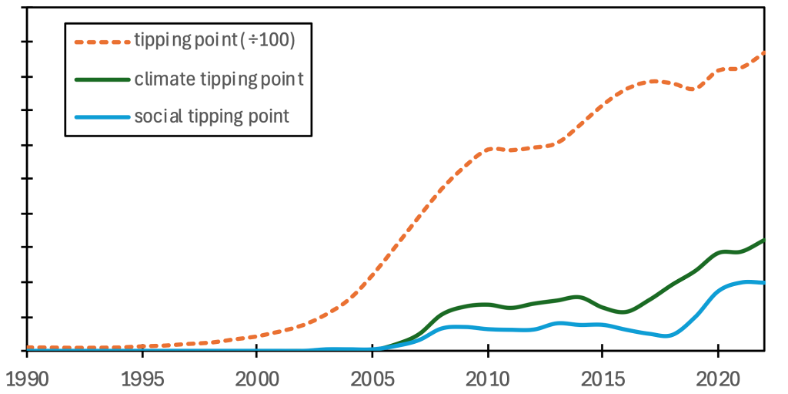
The term “point” also implies a model of unidimensional and inevitable change. Push a system sufficiently far along one single dimension, such as warming or the percentage of the population protesting on the streets, and change becomes inevitable. But complex systems are multidimensional. Think of the coral reef example: It’s not just temperature but also many other environmental variables that determine how long a reef can last.
In social systems, it is almost never the case that a single identifiable cause will commit society to an irrevocable shift. There certainly are interventions that can substantially accelerate decarbonization and adaptation to climate change. However, these types of interventions almost always entail substantial social and political struggle involving governments, citizen groups, and industry groups. A high carbon price can be a high-impact policy, but the effort to get a high carbon price into place is multi-dimensional and entails social and political fights that often continue well after the policy is first enacted (Skocpol, 2013). The precipitous drop in US natural gas prices that made coal a less-preferred energy source is attributed to the successful commercialization of fracking, but this technology developed over the course of 50 years with investment from the US government. When implemented in the United States, minimum energy efficiency standards for residential appliances and lighting reduced product energy use by 10 to 30 percent within a year or two, but it took almost 30 years to implement these first standards after several negotiations and reversals by presidential administrations and the courts (Shwom, 2012). Change is, and remains, contested for long periods of time.
Similarly, discussions of negative tipping points often unjustifiably cement narratives of societal impacts following inevitably from exposure to climate hazards. Many of the purported causal pathways harken back to Mathusian visions of societal collapse rather than focus on addressing vulnerability, enhancing human agency, and providing more entry points for adaptation to reduce risk.
The “social tipping point” literature also elides a substantial degree of judgement in labeling certain tipping points as “positive” or “negative.” This issue, for example, labels a shift away from fossil fuels as positive. We agree, but others—as demonstrated by the challenges in negotiations on shifting away from fossil fuels in the international negotiations—do not. In 2023, the Secretary General of OPEC wrote to his members, imploring them to take action at international climate negotiations. He warned them that “undue and disproportionate pressure against fossil fuels may reach a tipping point with irreversible consequences”—a positive tipping point in the views of many, but negative in his (Friedman, 2023).
At its best, the tipping points framing is a fruitful metaphor, capable of sparking new ideas. Its formal framework does not hold up to how the term is actually used. In practice, it is best thought of as kin to vague, discipline-spanning terms like sustainability and resilience—it broadly references the potential for rapid change, but its specific meaning differs in different contexts. There is no effective way to police the boundaries of the concepts to ensure it is used only in the way tipping point theorists want it to be used.
Even if the framing is applied more metaphorically than technically, we can still ask—as we can of any conceptual metaphor—whether it is useful. For instance, given the goals of the frame’s early adopters in terms of motivating climate action, is it likely to spur climate action?
There is not much research addressing this question directly, but existing social science does offer pointers. For example, the fear created by the climate tipping points framing is likely to drive attention and online engagement. But the tipping points framing is not well aligned with conditions that promote policy change and widespread action.
Social psychology indicates that people are more likely to take action in advance to address threats when they are perceived as relatively certain and nearby, while most climate tipping points are uncertain and diffuse in space and time. In democracies, policy change is more likely after collective recognition of a crisis, often triggered by so-called “focusing events.” While this was not as true 20 years ago at the dawn of the tipping points framing, the world is now being inundated—literally—with potential focusing events for climate action: intense heat waves and flooding, widespread wildfires, and protracted droughts. If these are not sufficient to spur action commensurate with the scale of the problem (and they do not appear to be), that gap cannot be due to lack of either information or focusing events; rather, it is due to political barriers and value conflicts that the tipping points framing cannot address.
Climate tipping points have also been explored in popular entertainment, albeit often in a form that builds upon misunderstandings. Science fiction sometimes envisions climate tipping points as being obvious global phenomena that will break political logjams. Slightly ahead of the tipping points framing, the 2004 blockbuster movie The Day After Tomorrow dramatized, in a form greatly exaggerated in speed and magnitude, the collapse of the Atlantic Meridional Overturning Circulation and a rapidly ensuing Northern Hemisphere ice age. The novelist Nick Foster Googins, in his 2023 book The Great Transition, envisions a singular moment when the West Antarctic Ice Sheet starts collapsing, with ice avalanches streamed on video around the world for days on end. This is a misunderstanding of how ice sheets work, albeit one suggested by the tipping points metaphor itself. Across phenomena, the transitions labeled as “tipping points” are almost all ones that will be hard to recognize until they are in the rearview mirror. As a consequence, they are ill-suited to serve as focusing events.
Furthermore, use of the tipping points framing is not risk-free from a policy and governance standpoint. As noted before, the use of the term “point” implies the potential to identify a precise warming level beyond which a system commits to irreversible change. We can imagine a world in which we knew, for instance, that crossing with 1.5 degrees Celsius warming would irrevocably commit ice sheets, coral reefs, permafrost, and ocean circulation to collapse. If this were the case, then it might justify great effort to limit global mean warming to 1.49 degrees Celsius, even (for example) invoking emergency geoengineering measures to avoid crossing this critical point of no return.
Unfortunately, a fair number of people seem to believe that we live in this imagined world. The phrase “1.5 degrees Celsius tipping point,” which confuses a policy milestone established in the Paris Agreement with a physical property of the climate, is not uncommon. The World Economic Forum, for instance, has confidently (and quite wrongly) declared that “scientists have long warned that 1.5 degrees Celsius is a physical limit, not a political target” (World Economic Forum, 2024). And quite a few voices are already drawing connections between the near-certain overshoot of this policy milestone and solar geoengineering (Climate Overshoot Commission, 2023).
In fact, contrary to the World Economic Forum’s assertion, 1.5 degrees Celsius is a political target, not a physical limit. The thresholds for many so-called “climate tipping points” are deeply uncertain, though we can say confidently that the risk of large-scale climatic shifts increases with additional warming.
Aside from calls for potentially harmful emergency measures to avoid overshooting specific, arbitrary warming levels, this confusion could also lead to doomism, which can sustain political paralysis, delaying efforts to both reduce emissions and adapt to climate change. Doomism can also harm mental health—it is truly tragic that there are young adults who want children but are contemplating not having them because the world is overshooting a policy marker.
Further, when it becomes manifest in a decade or two that 1.5 degrees Celsius is not a physical limit, the confusion the tipping points framing provokes could challenge the credibility of the scientific community. We must be clear: 1.4 degrees Celsius is bad, 1.5 degrees Celsius is worse, and 1.6 degrees Celsius is even worse. Warming makes the world worse at an increasing rate. But crossing 1.5 degrees Celsius will not cause a sudden increase in human and ecological suffering. Crossing 1.5 degrees Celsius increases the urgency of reducing emissions, just as every increase in global temperature does; it does not decrease it.
The phenomena discussed in this issue are all real. They are all important. And what makes them critical to study is not whether they fit some shifting definition of “tipping point,” but that they are potential “inevitable surprises,” like those discussed in the 2002 National Research Council report. We may not be able to say how likely they are, but their likelihood is not zero, and they could have profound effects if they occurred.
There is plenty we do know about climate change with substantially more certainty. We know that it is already harming people around the world, and we know that accelerated decarbonization and adaptation are already needed to manage current and readily foreseeable climate impacts, especially for those on the frontlines. Every ton of greenhouse gas counts.
Funding
The research underlying this work, published in Kopp et al. (2024), was supported in part by US National Science Foundation awards 2334276 and 2103754, the latter as part of the Megalopolitan Coastal Transformation Hub (MACH). This is MACH contribution number 41-A.
Together, we make the world safer.
The Bulletin elevates expert voices above the noise. But as an independent nonprofit organization, our operations depend on the support of readers like you. Help us continue to deliver quality journalism that holds leaders accountable. Your support of our work at any level is important. In return, we promise our coverage will be understandable, influential, vigilant, solution-oriented, and fair-minded. Together we can make a difference.
Keywords: climate change, science communication, tipping points
Topics: Climate Change, Special Topics



